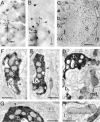The connection from cortical area V1 to V5: a light and electron microscopic study
- PMID: 9852590
- PMCID: PMC6793364
- DOI: 10.1523/JNEUROSCI.18-24-10525.1998
The connection from cortical area V1 to V5: a light and electron microscopic study
Abstract
Area V5 (middle temporal) in the superior temporal sulcus of macaque receives a direct projection from the primary visual cortex (V1). By injecting anterograde tracers (biotinylated dextran and Phaseolus vulgaris lectin) into V1, we have examined the synaptic boutons that they form in V5 in the electron microscope. Nearly 80% of the target cells in V5 were spiny (excitatory). The boutons formed asymmetric (Gray's type 1) synapses with spines (54%), dendrites (33%), and somata (13%). All somatic targets and some (26%) of the target dendritic shafts showed features characteristic of smooth (inhibitory) cells. Each bouton formed, on average, 1.7 synapses. The larger boutons formed multiple synapses with the same neuron and completely enveloped the entire spine head. On most dendritic shafts and all somata the postsynaptic density en face was disk-shaped but in about half the cases the reconstructed postsynaptic densities of synapses on spines appeared as complete or partial annuli. Even in the zones of densest innervation only 3% of the asymmetric synapses were formed by the labeled boutons. Although the V1 projection forms only a small minority of synapses in V5, its affect could be considerably amplified by local circuits in V5, in a way analogous to the amplification of the small thalamic input to area V1.
Figures













References
-
- Adelson EH, Movshon JA. Phenomenal coherence of moving visual patterns. Nature. 1982;300:523–525. - PubMed
-
- Ahmed B, Anderson JC, Martin KAC, Nelson JC. Polyneuronal innervation of spiny stellate neurons in cat visual cortex. J Comp Neurol. 1994;341:39–49. - PubMed
-
- Ahmed B, Anderson JC, Martin KAC, Nelson JC. Map of the synapses onto layer 4 basket cells of the primary visual cortex of the cat. J Comp Neurol. 1997;380:230–242. - PubMed
-
- Allman JM, Kaas JH. A representation of the visual field in the caudal third of the middle temporal gyrus of the owl monkey (Aotus trivirgatus). Brain Res. 1971;31:85–105. - PubMed
-
- Baude A, Nusser Z, Molnár E, McIlhenny RAJ, Somogyi P. High-resolution immunogold localization of AMPA type glutamate receptor subunits at synaptic and non-synaptic sites in rat hippocampus. Neuroscience. 1995;69:1031–1055. - PubMed
Publication types
MeSH terms
Grants and funding
LinkOut - more resources
Full Text Sources
Research Materials
